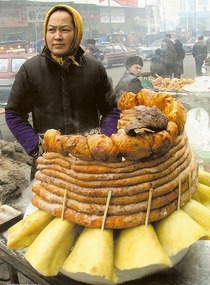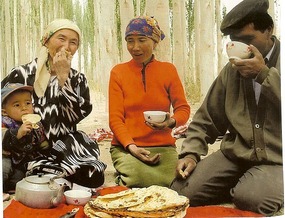Toward Turpan - Our Welcome to Xinjiang Province!
Wednesday, October 24, 2007
 Turpan, Xinjiang, China
Turpan, Xinjiang, China
Xinjiang Province, China
The oasis city of Turpan was our introduction to the immense Xinjiang Province where we were to travel for the remainder of our stay in China. Xinjiang means “New Frontier” and for us, it was very much part of the remote and "distant Chinas" we visited on this trip.
Bigger than Alaska, Xinjiang is China's largest provincial level administrative region and covers an area of 1.6 million square kilometers. It has been described widely as being “a separate country enclosed within China”. It certainly felt like it was. And it felt entirely foreign to the eastern and southern parts of China that we had become familiar with on our previous travels.
The province borders Tibet, and India's Leh district to the south and Qinghai and Gansu provinces to the south-east, Mongolia to the east, Russia to the north, and Kazakhstan, Kyrgyzstan, Tajikistan, Afghanistan, Pakistan and India to the west. Xinjiang oozes with the ancient history of the the Silk Road and for centuries the region was part of the great trading routes between Asia and Europe. It is no wonder that it is a province of great cultural diversity and ethnic fusion.
Xinjiang is largely desert bordered by the enormous mountains of the Tian Shan in the north, the Pamirs in the west, the Kunlun Shan in the south and the Altun Shan in the south-east, and is home to some of the highest mountains in the world. Within the central Tarim Basin lies the enormous expanse of the feared and mighty Taklamakan Desert which stretches across most of the southern section of the Province.
Xinjiang, also known locally as Eastern Turkestan, is home to nearly 50 different ethnic minorities. In terms of language, there are two main categories: Turkic and non-Turkic. The religion of the main cultural groups of Uighur, Kyrgyz, Kazakh, Tajik and Hui is Islam. With a long history of dissent and a largely Muslim population desperately wanting independence as well as its enormous oil reserves, it is no wonder that Chinese authorities are sensitive about the region and concerned about its close geographic proximity to neighbouring Muslim nations, especially the more militant countries of Afghanistan and Pakistan. And sadly there is always underlying racial tension in Xinjiang Province between the fiercely proud Uighur peoples, the Han Chinese people and the Chinese authorities.
Food also reflects the diverse cultural influences in Xinjiang. Market stalls and small restaurants sell an exotic array of gorgeous flat breads along with ubiquitous smoking hot mutton and chicken kebabs, samosas and other delicious smelling delicacies. We found the food fabulous, but nothing like the cuisine we enjoyed in the eastern and southern parts of China. We could have been in another world away from the China we had become accustomed to.
Also the time in Xinjiang is an important consideration. Although officially it goes by Beijing time, locally the time is two hours behind which can make organising times for pick-ups, meals etc a bit interesting.
We loved Xinjiang and remain intrigued that it is largely off the standard tourist path. This of course is yet another attraction. It is virtually tourist free and the people are warm, friendly and cheerful. As you will see from our travels throughout the province, it was the good natured and helpful people of Xinjiang that made our trip so very special.
Note: Photos of "Street Stall Seller, Xinjiang Province"and "Uighur Family, Xinjiang" were scanned from China Today, Vol. 53 No. 10, October 2004
Other Entries

 Turpan, Xinjiang, China
Turpan, Xinjiang, China



2025-05-23